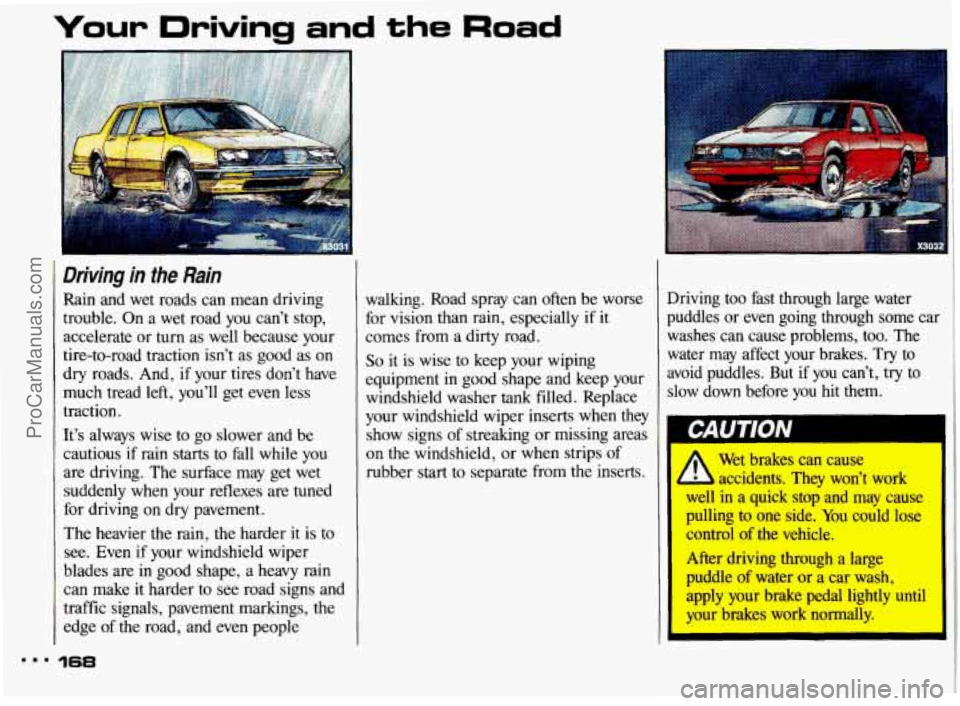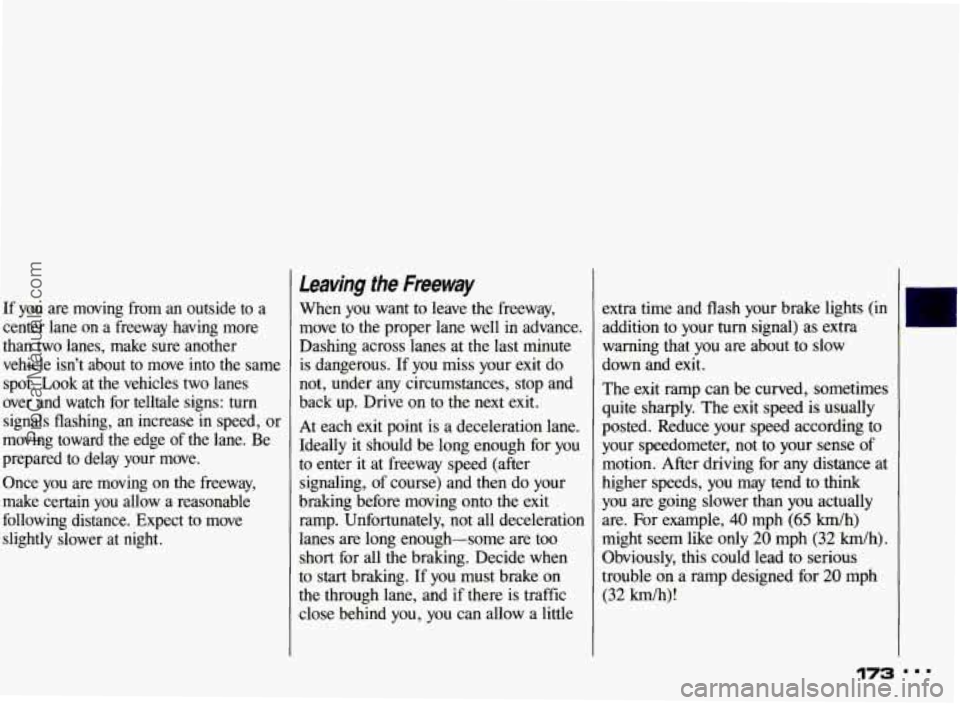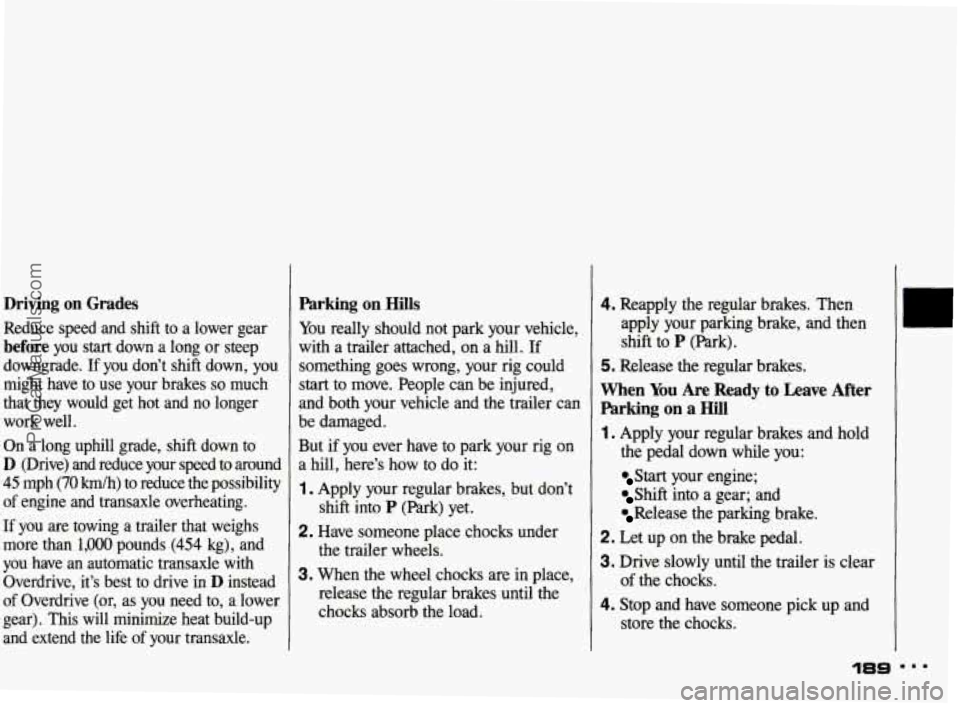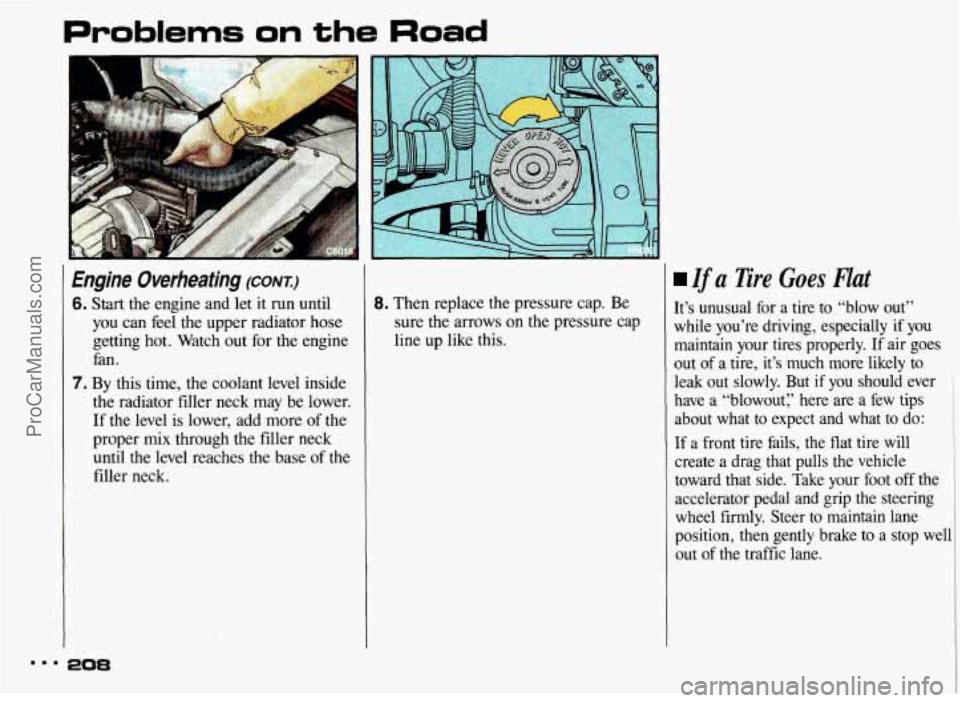1993 PONTIAC BONNEVILLE stop start
[x] Cancel search: stop startPage 169 of 322

Your Driving and the Road
I
Driving in the Rain
Rain and wet roads can mean driving
trouble. On a wet road you can’t stop,
accelerate or turn as well because your
tire-to-road traction isn’t as good as on
dry roads. And,
if your tires don’t have
much tread
left, you’ll get even less
traction.
It’s always wise to go slower and be
cautious
if rain starts to fall while you
are driving. The surface may get wet
suddenly when your reflexes are tuned
for driving on dry pavement.
The heavier the rain, the harder
it is to
see. Even
if your windshield wiper
blades are
in good shape, a heavy rain
can make
it harder to see road signs and
traffic signals, pavement markings, the
edge of the road, and even people
168
walking. Road spray can often be worse
for vision than rain, especially
if it
comes from a dirty road.
So it is wise to keep your wiping
equipment
in good shape and keep your
windshield washer
tank filled. Replace
your windshield wiper inserts when they
show signs of streaking or missing areas
on the windshield, or when strips of
rubber start
to separate from the inserts. Driving too fast through large water
puddles
or even going through some car
washes can cause problems, too. The
water may affect your brakes. Try to
avoid puddles.
But if you can’t, try to
slow down before you hit them.
I
u I I(
Wet brakes can cause
l accidents. They won’t work
w in a quick stop and may cause
pulling to one side. You could lose
control
of the vehicle.
After driving through a large
puddle
of water or a car wash,
apply your brake pedal lightly
until
your brakes work normally.
ProCarManuals.com
Page 172 of 322

something between you and moving
vehicles-space, trees, telephone poles,
a private driveway, anything that
removes
you from other traffic.
If visibility is near zero and you must
stop but
are unsure whether you are
away from the road,
turn your lights on,
start your hazard warning flashers, and
sound your
horn at intervals or when
you hear approaching traffic.
Pass other vehicles in fog only if you
can see far enough ahead to pass safely. Even then, be prepared to delay your
pass if you suspect the fog
is worse up
ahead.
If other vehicles try to pass you,
make it easy for them.
City Driving
One of the biggest problems with city
streets
is the amount of traffic on them.
You’ll want to watch out for what the
other drivers are doing and
pay attention
to traffic signals.
Here are ways
to increase your safety in
city driving:
Know the best way to get to where you
are going. Try not to drive around
trying to pick out a familiar street or
landmark. Get a city map and plan
your trip into an unknown part
of the
city just as you would for a cross-
country trip.
Try to use the freeways that rim and
crisscross
most large cities. You’ll save
time and energy. (See the next section,
Freeway Driving.)
Treat a green light as a warning
signal.
A traffic light is there because
the corner is busy enough
to need it.
When a light turns green, and just
before you
start to move, check both
ways for vehicles that have not cleared
the intersection or may be running the
red light.
remember that they are for ideal road,
weather and visibility conditions. You
may need to drive below the
posted
limit in bad weather or when visibility
is especially poor.
clear of intersections when you see or
hear emergency vehicles.
Obey all posted speed limits. But
Pull to the right (with care) and stop
171
ProCarManuals.com
Page 174 of 322

If you are moving from an outside to a
center lane on a freeway having more
than two lanes, make sure another
vehicle isn't about to move into the same
spot. Look at the vehicles two lanes
over and watch for telltale signs: turn
signals flashing, an increase in speed, or
moving toward the edge
of the lane. Be
prepared to delay your move.
Once you are moving on the freeway,
make certain you allow a reasonable
following distance. Expect to move
slightly slower at night.
Leaving the Freeway
When you want to leave the freeway,
move to the proper lane well in advance.
Dashing across lanes at the last minute
is dangerous.
If you miss your exit do
not, under any circumstances, stop and
back up. Drive on to the next exit.
At each exit point is a deceleration lane.
Ideally it should be long enough for you
to enter it at freeway speed (after
signaling, of course) and then do your
braking before moving onto the exit
ramp. Unfortunately, not all deceleration
lanes are long enough-some are too
short for all the braking. Decide when
to start braking.
If you must brake on
the through lane, and if there is traffic
close behind you, you can allow a little extra
time and flash your brake lights (in
addition to your turn signal) as extra
warning that you are about to slow
down and exit.
The exit ramp can be curved, sometimes
quite sharply. The exit speed is usually
posted. Reduce your speed according to
your speedometer, not to your sense of
motion. After driving for any distance at
higher speeds, you may tend to think
you are going slower than you actually
are. For example,
40 mph (65 km/h)
might seem like only
20 mph (32 Wh).
Obviously, this could lead to serious
trouble on a ramp designed for
20 mph
(32 km/h)!
ProCarManuals.com
Page 190 of 322

Driving on Grades
Reduce speed and shift to a lower gear
before you start down a long or steep
downgrade. If you don’t shift down, you
might have to use your brakes
so much
that they would get hot and no longer
work well.
On a long uphill grade, shift down to
D (Drive) and reduce your speed to around
45 mph (70 km/h) to reduce the possibility
of engine and transaxle overheating.
If you are towing a trailer that weighs
more than
1,000 pounds (454 kg), and
you have an automatic transaxle with
Overdrive, it’s best
to drive in D instead
of Overdrive (or, as you need to, a lower
gear). This will minimize heat build-up
and extend the life
of your transaxle.
Parking on Hills
You really should not park your vehicle,
with a trailer attached, on a hill. If
something goes wrong, your rig could
start to move. People can be injured,
and both your vehicle and the trailer can
be damaged.
But if you ever have to park your rig on
a hill, here’s how to do it:
1. Apply your regular brakes, but don’t
shift into
P (Park) yet.
2. Have someone place chocks under
the trailer wheels.
3. When the wheel chocks are in place,
release the regular brakes until the
chocks absorb the load.
4. Reapply the regular brakes. Then
apply your parking brake, and then
shift to
P (Park).
5. Release the regular brakes.
When You Are Ready to Leave After
Parking on a Hill
1, Apply your regular brakes and hold
the pedal down while you:
Start your engine;
Shift into a gear; and
Release the parking brake.
2. Let up on the brake pedal.
3. Drive slowly until the trailer is clear
4. Stop and have someone pick up and
of the chocks.
store the chocks.
ProCarManuals.com
Page 209 of 322

Problems on the Road
I Engine Overheating (CONT.)
6. Start the engine and let it run until
you can feel the upper radiator hose
getting hot. Watch out for the engine
fan.
7. By this time, the coolant level inside
the radiator filler neck may be lower.
If the level is lower, add more of the
proper mix through the filler neck
until the level reaches the base of the
filler neck.
8. Then replace the pressure cap. Be
sure the arrows on the pressure cap
line up like this.
Ifa Tire Goes Flat
It’s unusual for a tire to “blow out”
while you’re driving, especially if you
maintain your tires properly. If air goes
out of a tire, it’s much more likely to
leak out slowly. But
if you should ever 1
have a “blowout:’ here are a few tips
about what to expect and what to do:
If a front tire fails, the flat tire will
create a drag that pulls
the vehicle
toward that side. Take your foot off the accelerator pedal and grip the steering
wheel firmly. Steer
to maintain lane
position,
then gently brake to a stop well
out of the traffic lane.
ProCarManuals.com